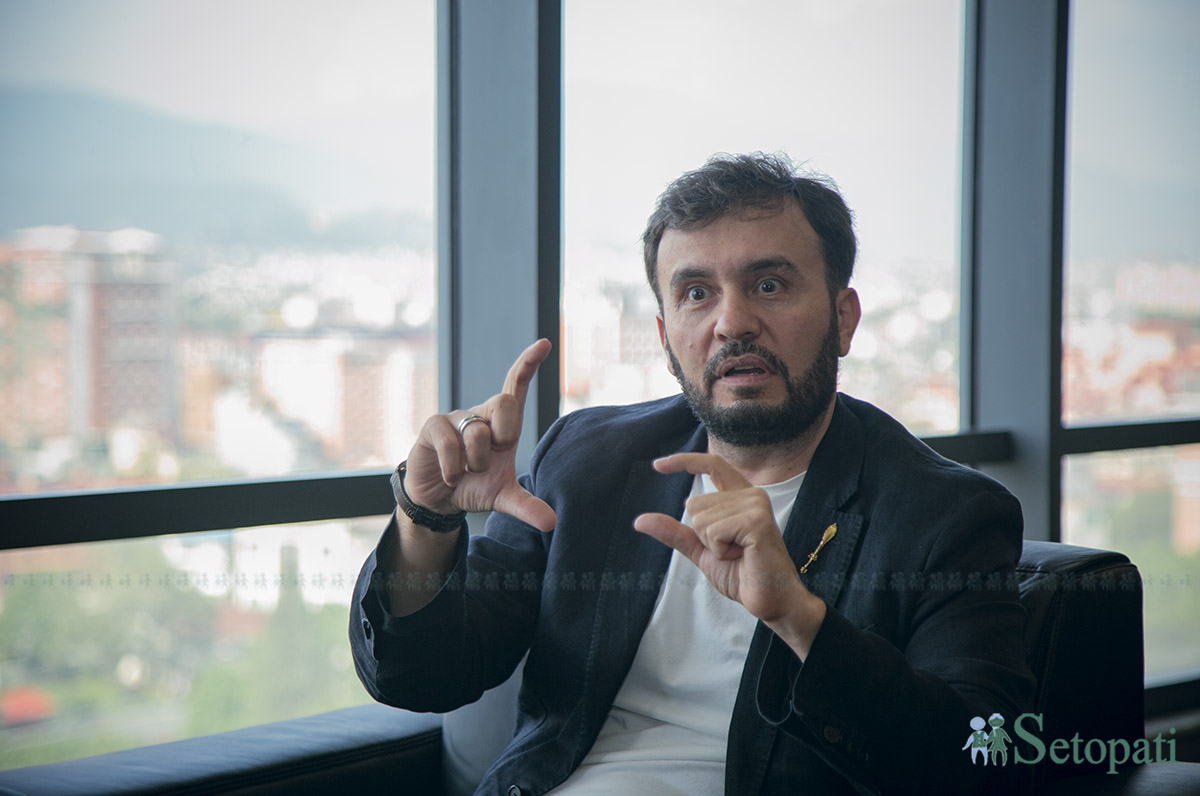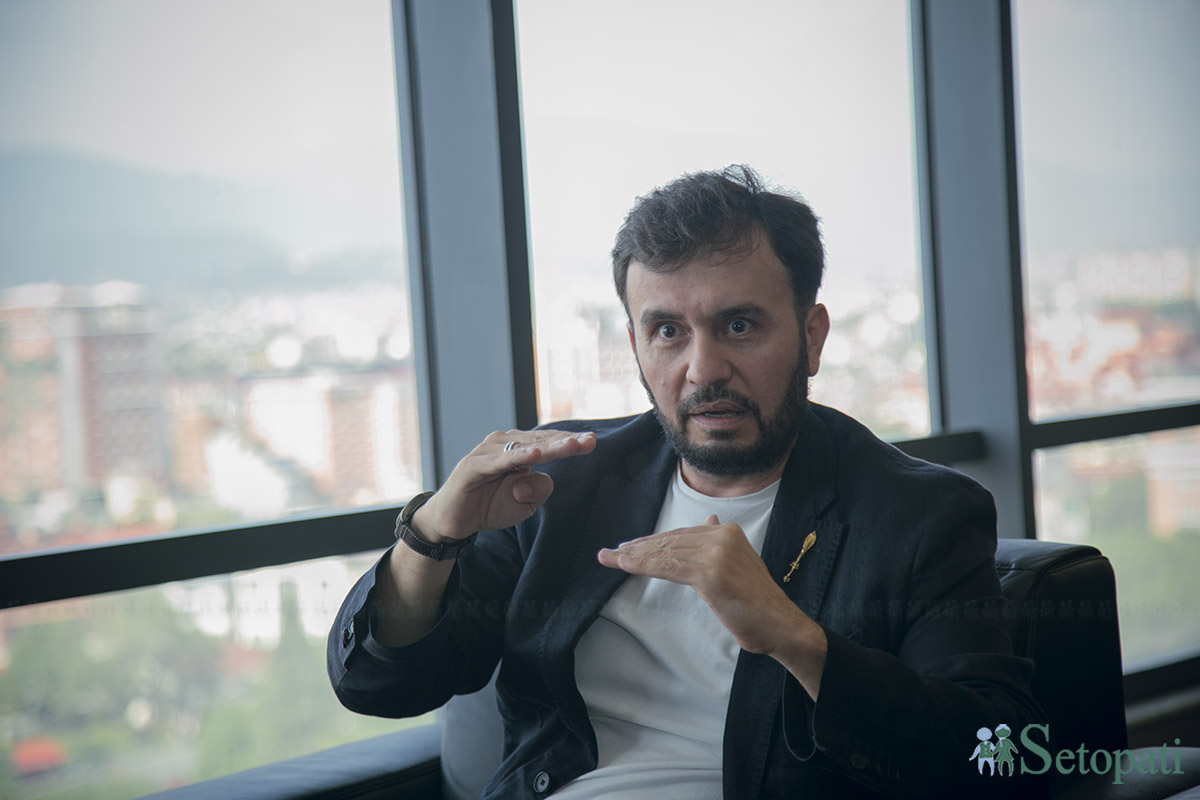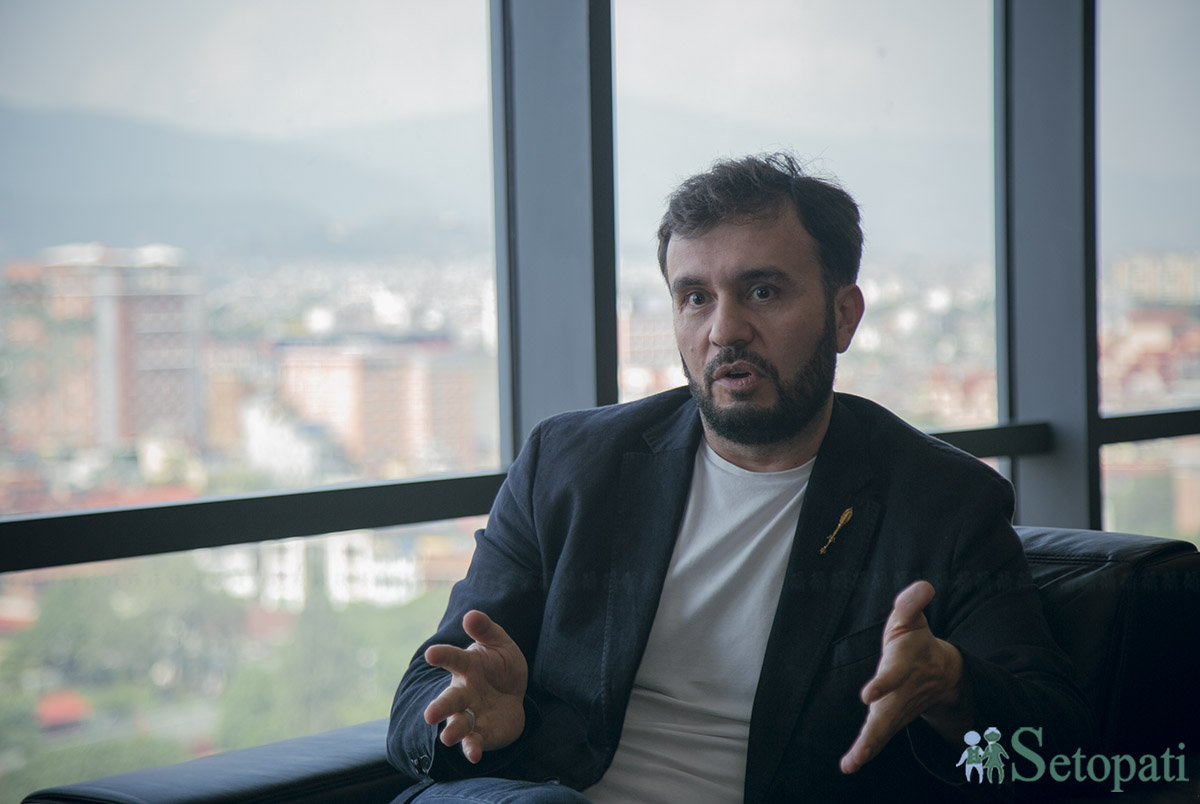Jabbor Kayumov, chief executive officer and managing director of Ncell, brings with him over 20 years of experience in senior management roles in the telecommunications industry worldwide. Kayumov has worked with some of the biggest names in the telecom industry such as Telia, Veon, and Digicel.
In the first 15 months of him spearheading Ncell, Kayumov has helped Ncell transition into a 100 percent Nepali-origin-owned company. His efforts are unflinching and his vision for Ncell is persistent. He is a staunch supporter of everything for Nepal and Nepali people with the helms of Ncell leading the way forward. With the launch of the recent 'Sadhain ON' campaign, he is all set to lead a turnaround of business operations transitioning Ncell into becoming a digital operator contributing toward the Digital Nepal Vision by empowering the customers to always keep the data on, simplifying the lives of Nepali customers, and creating a foundation for the future of 5G in Nepal.
Driven by his keen interest in advancing technologies and the growing needs of customer-focused innovative products and services, Kayumov believes that to be successful in digital innovation, a collaborative environment is essential to drive high customer satisfaction and business results.
In this interview, Chetana Guragain and Juna Shrestha caught up with Kayumov to discuss about data consumption, consumer behavior, the newly-launched campaign Sadhain ON, and the way forward. Here are the excerpts.

How much data are Nepalis consuming per head compared to their South Asian counterparts?
The average data user consumes about 20 GB per month, and it is growing, as per the global benchmark. The developed countries’ users consume more data based on the technologies they have. In such countries, they are using 5G and advanced LTE. South Asian countries like India, Bangladesh, and Sri Lanka consume data ranging between 13 GB and 20 GB. Whereas Nepal is only consuming 4 GB of mobile data per head, which is far from the global benchmark.
Daily mobile data usage remains very low — only 2 out of 10 Nepalis use mobile data regularly which we expect to increase to 7-8 out of 10 in the next few years. And for that, we have taken a bold step to disrupt the market by launching Sadhain ON. Sadhain ON is a movement to empower our customers to always keep the data on by simplifying life and encourage customers to use phones more productively. This is where the rest of the world is headed to ensure the future digital progress and sustainability of the industry, and we don't want Nepal to be left behind. Nepal is currently 109th in mobile broadband speed. In the next few years, we want Nepal to be in the top 50 with public and government support.
So Sadhain ON is about creating a foundation for the future, and the future is 5G and more. My dream is for Nepal to be the first country after India to bring 5G in South Asia. 5G doesn’t just mean 100 times faster Internet, what it really means is the ability to introduce cutting edge technology that can have a significant impact on development, from agriculture to telemedicine, education to mobility, tourism and even things we can’t imagine yet.
Why do you think data consumption is low in Nepal? Do telecom industries struggle to sell data?
Nepali consumer behavior is different from the rest of the world. Average Nepalis keep their mobile data off. They turn it on when they need to or when there is no Wi-Fi. Many consumers here have become 'Wi-Fi-hunters'. It is quite a strange behavior when compared to the rest of the world. Almost 90% of Nepal has 4G coverage. But people are not using it when actually they need it.
Regarding the struggle of selling data, I think the answer is more yes than no. Customers are hesitant to use data just because of misconceptions and myths. Many consumers have the misconception that telecom companies consume data without the user's knowledge or permission when data is turned on. Therefore, they turn it off unless necessary. However, this is not the case. It is a lack of clear information about the packs and plans provided by the telecom company and some customer journeys that Ncell wants to change to ensure that there is no bill shock and your smartphone won’t do things you don’t want it to do.
In the age of the Internet, information, and technology, how does this low data consumption affect Nepal?
Internet connects users with opportunities. There is no practical benefit for users in keeping data turned off. This limits them. The global market is 'on' 24/7. Every second, something is happening. To stay informed about it, users also need to be 'on,' that is, online. The more access there is to the Internet and information technology, the more successful one can be. With limited access, Nepal cannot get closer to the present and future of the world. The digital advancement that the government has envisaged, our telco to techco journey, and of course the much talked about 5G utilization depend on how our market uses the latest technologies to advance. Especially, after the launch of 4G in 2014, the charge that telecom operators collect has come down significantly and it doesn’t stop here; we have brought down the cost of data further.
Are Nepali telecom industries willing to invest to improve per capita data consumption in Nepal and to upgrade telecom infrastructure to foster economic growth?
In our industry, we have average revenue per customer, and at the same time, we have average GB consumption per customer. We want to make data affordable so that our users are not dependent on Wi-Fi only.
The launch of Ncell ‘Sadhain ON’ in May 2024 and ‘Biz Sadhain ON’ in July 2024 are some recent steps that we have taken. We want to make the experience and use of data simpler, customer-centric, and affordable. Nepali telecom companies are willing to invest much to improve the customer experience and for telecom sector development. Some of the examples include our 4G enhancement in provinces such as Gandaki, Lumbini, Sudurpaschim, Madhes and Bagmati.
At the same time, it needs commitment from the authorities concerned to make the telecommunications sector in Nepal more competitive by providing an equal level playing field to the existing service providers among mobile and fixed operators. One such initiative is to make sure that the mobile operators and fixed Internet service providers are treated as rationally as possible. Wi-Fi and abundantly available hotspots allow fixed service providers to infringe upon the territory of mobile operators which in a way has also caused revenue leakage for the government.

There has been a lot of buzz about Ncell’s ‘Sadhain ON’ lately and now there is ‘Biz Sadhain ON’. Can you explain these campaigns in more detail?
‘Sadhain ON’ is a campaign to make people understand that everyone can and should be always on in order not to be left behind. So, it's a special customer pack that includes calls, SMS, and data all in one package. It is very simple to understand and includes freebies, allowing people to enjoy access to social media with free data volume. It is not necessary to purchase SMS, voice, or data packs separately. You can use the Ncell App or dial *123# to purchase this pack.
For those who have been overpaying to use the internet on their mobile phone, it is an opportunity to optimize the expense because the user can get more for less. At only Rs. 399, one can have up to 12 GB of data, 399 minutes and 399 SMS for 28 days. This is three times more than the average consumption itself and at least twice cheaper than buying it separately. In case you are out of data, you can go higher and buy a pack of Rs. 499 all the way to Rs 1,499 or buy boosters. As of today, for approximately two months we have already crossed over a million users for Sadhain ON packs. Some customers are liking it so much that they are even asking for auto-renewal or upgrading now to PostPaid BIZ Sadhain ON.
Would you please also elaborate on ‘Biz Sadhain ON’?
After the launch of Sadhain ON for mass consumers we faced so many requests from our corporate customers to have the same approach for them, so, we have now launched ‘Biz Sadhain ON’, especially designed to support Nepali organizations and businesses of all sizes, including large enterprises and SMEs, by providing innovative solutions and growth opportunities. This plan offers the benefits of no unexpected bills, carryover of unused resources, and reliable, worry-free month-long connectivity along with bundled services. This initiative marks yet another step toward a 5G future.
With Biz Sadhain ON and our different solutions suites, we are focused on supporting simplified operations, enhancing productivity, and empowering Nepali businesses to achieve their full potential that lays the foundation for a true digital economy. It comes with five major monthly rental plans starting from Rs. 499 and moving up to Rs. 1,949. Higher resources—data, voice, and SMS bundled with Lionsgate Play, one of the world’s leading standalone, pure-play, publicly traded content companies, and the Mero Lagani App, which tracks share profit and loss, are the features of these plans. For instance, the Rs. 499 monthly plan includes 17 GB data, 600 minutes of all-Nepal calls, and 600 local SMSes. Similarly, in the Rs. 999 monthly plan, we provide 60 GB data, unlimited all-Nepal calls, and 1,000 local SMSes. For even bigger bundled services, we have monthly plans of Rs. 1,599 and 1,949.
If customers run out of resources, they can continue browsing at 5 paisa per MB or Rs. 50 per GB which is 20 times lower than the industry Pay As You GO (PAYG) rate. Also, they can buy Booster Packs for data or voice calls. Biz Sadhain ON customers also get access to a Special Service Line 9007/9809007000 for customer care and privilege counters.
The industry is evolving, and demand from Nepali enterprises is rising. Countries like Singapore, UAE, and our neighbor India are rapidly advancing due to innovations such as 5G, IoT, cloud and AI. These innovations are revolutionizing how businesses operate, interact with customers, and drive efficiencies. Ncell is working to provide these solutions in Nepal to address the pain points of enterprises and help them grow. Some of such solutions are ready with us and some are in the pipeline. Together, we can tap into the power of connectivity, advanced technologies, and innovative solutions to unlock new opportunities and drive sustainable growth in the digital economy for the Digital Nepal Vision 2.0.
For enterprises, we also have services that include Toll-Free services, SIP solutions, National and Global Connect services, Data Center Co-location, high-speed Biz Internet, Bulk SMS solutions, Virtual Private Servers, and Analytics as a Service. These products and services are designed to meet the diverse needs of Nepali enterprises, empowering them with advanced technologies and reliable infrastructure to drive their businesses forward in today's dynamic market landscape.
5G is a reality in many countries, and people in the telecom industry are already talking about 6G. But Nepal seems to be far away from adopting 5G infrastructure. Why?
Every new technology requires significant investment from both service providers and consumers. A new mobile (device) capable of running 5G is necessary. This investment comes from the customers. Currently, only 5% of the devices used in Nepal can support 5G. Rough estimates suggest that deploying 5G in Nepal would require an investment of up to USD 500 million. Investors need to be assured of returns to make such a large investment. They need to see a secure future. Otherwise, who would invest and why?
At this time, 5G is essential. Even if it takes five to ten years, 5G must be initiated and utilized. Otherwise, Nepal will fall far behind compared to the global market.
My dream is for Nepal to become the first country after India to bring 5G in South Asia. These may seem like small improvements, but it makes a whole lot of difference for visitor and user experience and paves the way for a truly digital Nepal as envisioned by the government.
We want Nepali customers to be using their phones like the rest of the world, we want our wireless services to be on par with the rest of the world. With Sadhain On, we are taking the first step into the future.
If all related sectors make an effort and regulatory bodies facilitate, 5G is possible; everything is possible, but the government and the private sector should work hand-in-hand.

In the context of digital transformation, where do you see Nepal in five years? What suggestions would you give to the government and the private sector to make digitization more effective and move forward at a faster pace?
Predicting the future is tough. I don't know what will happen in the next five years, but we are clear about what we want to achieve. We want to bring Nepal into the top 50 in the mobile broadband sector and all Nepali brothers and sisters to have access to the latest technologies in the most affordable way. We want to see at least the major cities in Nepal get fully digitized. And we want to see 5G in use in Nepal serving the needs of future progress.
We have a lot of work left to do. These tasks need to be completed as quickly as possible. We do not have time to postpone or sit back and watch. If we do, we will fall far behind in the global market, even compared to the South Asian market, and that will further cut into our economy’s ability to compete. There is still a lot of work to be done by the government and private sector to accelerate digitization. If we are to compete in the global market, all tasks must now be done quickly, and right decisions have to be taken soon. All I can say is what Ncell has been saying for quite some time – Ncell is here to support and Ncell is here for Nepal.
What specific policy changes or reforms would be necessary to improve the environment for Foreign Direct Investment (FDI) in Nepal?
I really don’t know, but what I hear from experts – many, many policies need to be updated. New rules that are suitable for the future need to be introduced. Investment regulations need to be revised. Nepal's Telecommunications Act and other rules are outdated. They need to be modified according to the current requirements. Compared to neighboring countries, Nepal attracts less foreign direct investment. The reason neighboring countries can attract more foreign direct investment is that their related policies and regulations are more conducive to foreign direct investment.
In some regards, Nepal’s telecom industry is in crisis. There is a significant opportunity to solve this now and create incentives for investment and innovation in this sector. We are making every effort to bring about change to Nepal's telecom sector. However, change will not happen unless all stakeholders involved in this sector build a common understanding and work together.
Therefore, we appeal to all the government agencies to analyze the emerging challenges and opportunities in this sector. We hope the government will understand the opportunities and the challenges and work accordingly. If we want to make Nepal’s telecom sector competitive compared to the rest of the world, we must act now. And Ncell now being a 100 percent Nepali-origin-owned company is ready to do its utmost in supporting the leadership to succeed.
Can operators like Nepal Telecom and Ncell financially sustain basic voice and data services in the future?
I believe they can for some time only, subject to some basic changes that have to take place, but I don’t think progress and growth of the future will be there without evolution. So, evolution of both operators Ncell and NTC is a must. Look, Ncell started 20 years ago in Nepal. Then it provided only 2G service that was only in voice. Then there was a business model that served the purpose, and for 10 years it was going great. Then new technologies like 3G and 4G came and enabled new behavior and customer demand that stimulated development of different social media, digital apps, and platforms. In the last decade, digitalization has been rapid. In this scenario, the old telco model is no longer fit for purpose. So, it's impossible for service providers to stay on the market with only voice and data. Therefore, we are evolving from telco to techco, according to the changing market and customer needs.
Ncell has applied for a license renewal and has said it will pay 20 billion rupees in renewal fees in installments. The Nepal Telecommunications Authority (NTA) has already rejected the offer. Have you been in dialogue and negotiation with the NTA and government on this? What is the current status of license renewal?
First of all, I want to believe that there wasn’t any rejection of our request for installment, and Ncell and NTA are working to facilitate the process to ensure smooth operation and license renewal. When it comes to the payments, the situation is that Ncell is asking NTA as our regulator to ensure that we are treated equally with other telecom companies. By any means we are not asking for any special treatment. We have already paid 4 billion rupees in advance for the next five years, when Nepal Telecom (NTC) recently paid 20 billion rupees for the last five years only. In advance versus for the past, you see the difference. If we were to be treated equally, we would have been asked to pay 20 billion rupees after 5 years. But we have paid 4 billion rupees in advance and we are asking for an installment facility as a good practice of the last 10 years and are not asking to pay only after 5 years like NTC, when even some parties might think that Ncell should be provided the same facility and pay only after 5 years.
The interpretations seem to be that we Ncell are asking for special treatment. We are not asking for it. To be honest, Ncell is asking for less than equal if you look at the situation objectively. However, we are in active discussion with NTA, and as I already said, we are hopeful for a positive resolution.
How are the taxes and fees imposed on the telecom sector impacting major operators like Ncell and NTC? Are the taxes and fees eventually transferred to consumers?
The tax burden of telecom is high. On the other hand, the telecom business is not like other businesses where, after investing once, one can enjoy it for the rest of the time. On average, every five years we have to invest 500 million dollars in new technologies and upgrades to meet the customers' demand and ensure the quality of service.
From the charge telecom companies take from the customers, almost 50 percent goes as taxes and fees to the government. For example, if I am charging 100 rupees from a customer, I pay around 26 rupees to the Nepal government on taxes, e.g., Telecommunication Service Charge, Ownership Tax, Value Added Tax, Royalty and Rural Telecommunication Development Fees. Over and above that, there is the license renewal fee of 20 billion rupees that we pay every 5 years. There are also frequency fees and customs duty for all imports. On different headings, we contributed over 19 billion rupees during last year only toward the government exchequer. The rest of the money goes toward maintenance of the infrastructure, salaries to the staff working to provide services, and miscellaneous expenses. Now, what remains after meeting those expenses and after-tax payment is profit. The profit can go either to company shareholders or to new investment. And as you see, 7-10 billion rupees is required annually as an investment.
Yes, every year, we make a huge investment as capital investment to keep our services up and running and maintain the quality of services that we offer. Nepal’s telecom industry has arrived at an alarming situation where the industry’s profit after tax is less than the investment required to maintain the network. I hope the government agencies will come to terms with this reality and we will work together so that the existing players will be able to commit more investment in the future.
The industry has been under severe pressure due to multiple challenges it has been facing over the past decade or so. As a result of this, over the past six years revenue of the telecommunications sector has declined by 26 percent. The decline has not been slowing down and it has been forecast that the industry will go into negative profitability over the next 2 years. Back in 2018, the sector posted an annual turnover of 100 billion rupees, which has now dropped to below 75 billion rupees and the outlook is gloomy. With the industry being financially non-profitable, it would result in the inability of telecom companies to further invest in maintaining the technology and bringing in new technology. So, now you see the urgency of the situation. The good news is that Ncell has a plan, and it is securing the future with 'Sadhain ON'. Of course, these are only the first steps and if our initiatives are supported and followed this will be something we all will be proud of.
What are your company’s plans for future investment in Nepal?
As of now, I will say that we are committed to continue investing and continue trying to turn around our and the industry’s performance. We are also very much committed to our CSR (Corporate Social Responsibility) agenda and coming up with more community projects. We are now going to provinces and rural parts of Nepal and hunting for projects within the framework set by the Nepal government and our board.
We are currently running the ‘18 for 18’ campaign as well, which was launched last September. In this, we are supporting 18 projects with 1 million rupees grant each. For now, we have already finalized 12 projects and another 6 are yet to be completed. The campaign targets more provinces rather than being Kathmandu-centric.
I actually think not many know that Ncell has spent around 2 billion rupees in CSR projects only including education, health, environment, sports sectors, and many more. I’m not sure there are many companies in Nepal that do this much for Nepali communities, and we will do more as we are here for Nepal.

